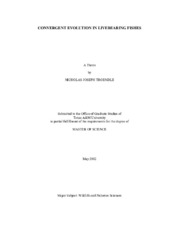| dc.description.abstract | The directionality and consistency of evolution has long been a subject of contention among evolutionary biologists since the days of Darwin. However, it is unknown how much can be quantified and how much results from more complex variables. It is also unknown whether evolution is consistent or whether it occurs differently in each system.
My study focuses on predation and habitat as ecological gradients that may create convergent evolution in livebearing fishes. In Chapter I, I focus on predation as a mechanism for driving convergent evolution in Gambusia affinis. A suite of 7 microsatellite markers was used in order to determine independence of morphological evolution. Mantel tests were used to compare genetic, phenotypic, geographical and environmental distances among the six focal populations. These tests showed that there was a significant correlation between genetic and geographic distance but no significant correlation between genetic and phenotypic distances, which may indicate that phenotypic divergence has arisen independently in multiple instances.
The second chapter focuses on a unique form of convergence that arose during speciation of three livebearing fishes, which we termed "convergent speciation." I focus on habitat type as a selective pressure in the lake system of Lake Catemaco, Mexico and the surrounding rivers. Lake Catemaco has been isolated from the surrounding rivers for approximately 1.2 million years and during that time several endemic species have evolved in the lake. This provides an excellent study system for studying convergent divergence. To test the theory of convergent speciation in this system, a MANOVA was conducted. The effect of habitat was an important source of variance in the system, indicating that habitat is a likely driving force responsible for convergent speciation in the system. Using discriminant functions I was able to correctly predict the habitat of fish of six different species between 68% and 71% of the time. This may indicate that evolutionary response to habitat is consistent across taxa (i.e., convergent divergence is taking place). | en |


